ignition AUDI A8 2014 Repair Manual
[x] Cancel search | Manufacturer: AUDI, Model Year: 2014, Model line: A8, Model: AUDI A8 2014Pages: 314, PDF Size: 78.47 MB
Page 210 of 314
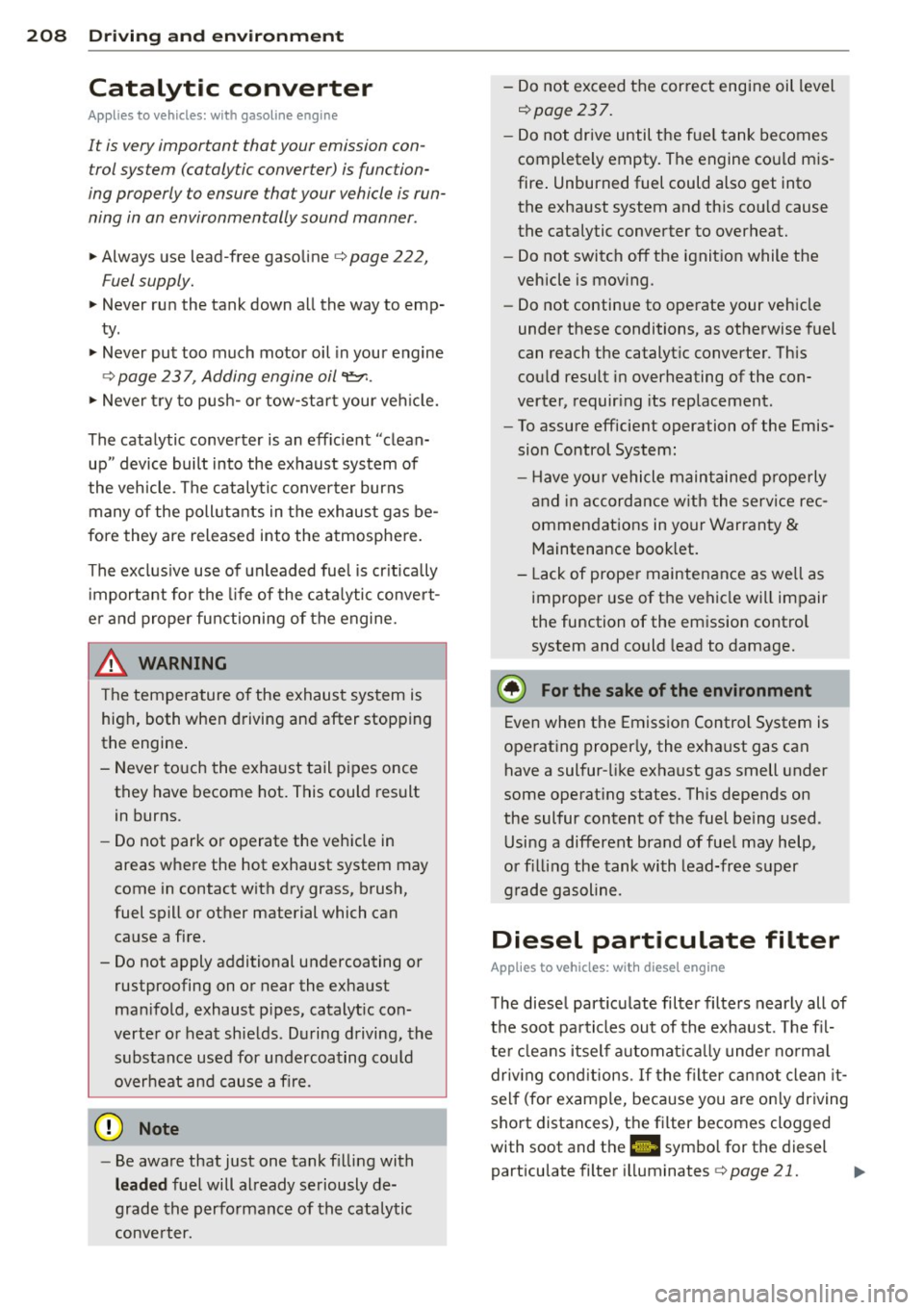
208 Driving and en vir onm ent
Catalytic converter
Appl ies to vehicles: with gasoline e ngin e
It is very important that your emission con
trol system (catalytic converter) is function
ing properly to ensure that your vehicle is run
ning in an environmentally sound manner .
.. Always use lead-free gasoline i=> page 222,
Fuel supply .
.. Never run the tank down all the way to emp-
ty .
.. Never put too much motor oil in your engine
¢ page 23 7, Adding engine oil
The catalytic converter is an eff ic ient "clean
up" device built into the exhaust system of
the vehicle. The catalyti c converter burns
many of the pollutants in the exhaust gas be
fore they are released into the atmosphere.
The exclus ive use of unleaded fuel is cr itically
important for the l ife of the cata lytic convert
e r and proper functioning of the engine.
A WARNING
T he temperature of the exhaust system is
high, both when driving and after stopping
the engine .
- Never touch the exhaust tail pipes once
they have become hot. This could result
in burns.
- Do not park or operate the vehicle in
areas where the hot exhaust system may
come in contact with dry grass, brush,
fuel spill or other material which can
cause a fire.
- Do not apply additional undercoating or
rustproofing on or near the exhaust
man ifold, exhaust p ipes, catalytic con
verter or heat shields . During driving, the
substance used for undercoating cou ld
overheat and cause a fire.
@) Note
- Be aware that just one tank f illing with
leaded fuel will already seriously de
grade the performance of the cata lytic
conve rter. -
Do not exceed the correct engine oil level
i=>page 237.
-Do not drive until the fue l tank becomes
completely empty . The engine co uld mis
fire . Unburned fuel could also get into
the exhaust system and this cou ld cause
the catalytic converter to overheat.
- Do not switch off the ignition while the
vehicle is mov ing.
- Do not continue to operate your vehicle
under these conditions, as otherwise fuel
can reach the catalyt ic converter. Th is
cou ld result in overheating of the con
verter, requir ing its replacement .
- To assure efficient operation of the Emis
sion Control System:
- Have you r vehicle maintained p roperly
and in accordance w ith the service rec
ommendations in your Warranty & Maintenance book let.
- Lack of prope r maintenance as we ll as
improper use of the vehicle wi ll impair
the function of the em ission contro l
system and could lead to damage.
@) For the sa ke of the en vironment
Even when the Emission Control System is
ope rat ing properly, the exhaust gas can
have a sulfur-like exhaust gas smell under
some operat ing states. This depends on
the sulfur content of the fuel being used .
Using a different brand of fuel may help,
or f illing the tank with lead-free super
grade gasoline.
Diesel particulate filter
Applies to vehicles: with diese l eng ine
The diesel part icu late filter filters nearly all of
the soot pa rticles out of the exhaust . T he fil
ter cleans itself automat ica lly unde r no rma l
dr iv ing cond itions . If the filte r cannot clean it
self (for example, because you are on ly driving
short distances), the filter becomes clogged
with soot and the
II symbol for the diesel
particulate filter i lluminates
i=> page 21. ..,.
Page 213 of 314
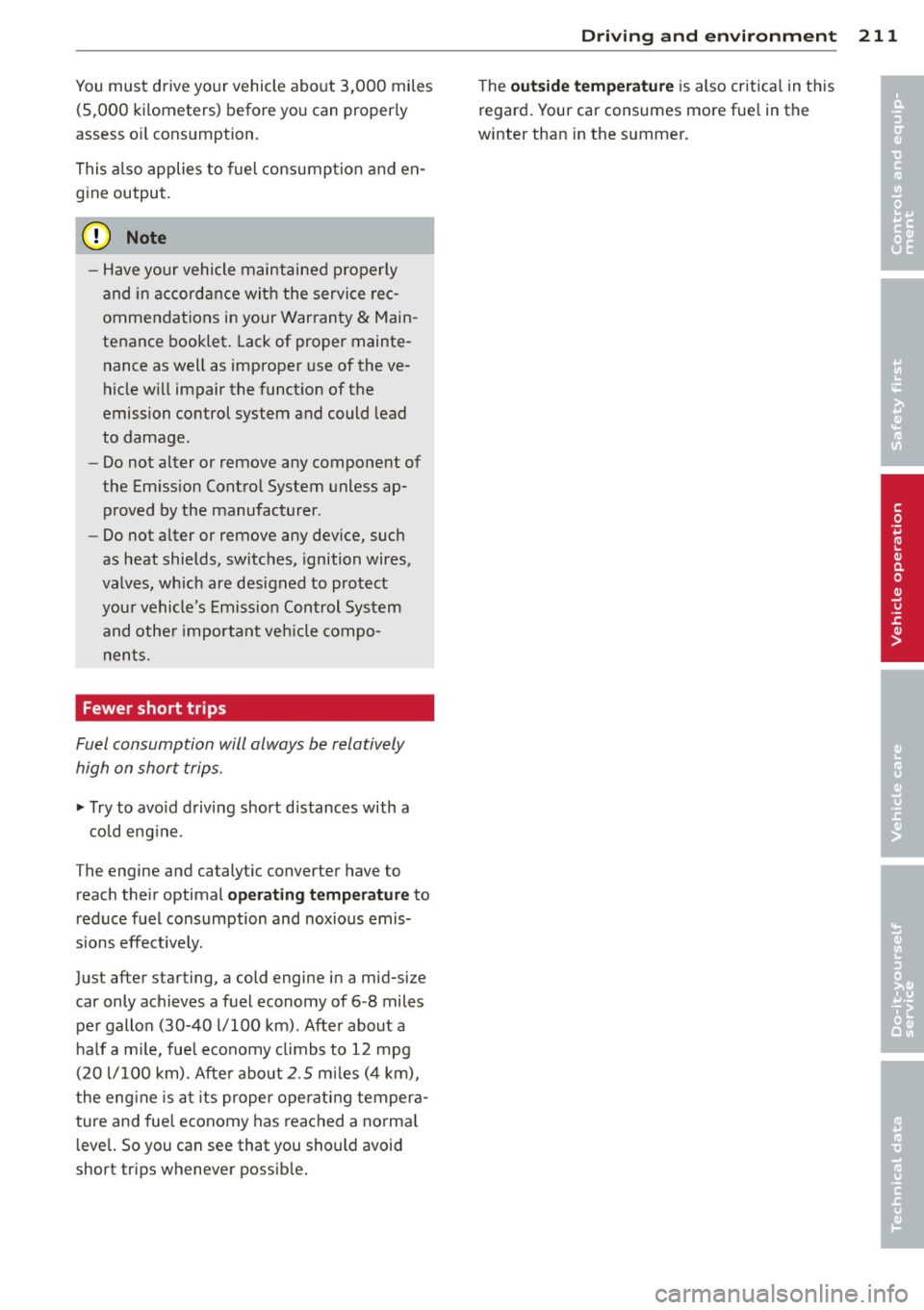
You must drive your vehicle about 3,000 miles (5,000 kilometers) before you can properly
assess o il consumption.
This also applies to fuel consumption and en
gine output.
(D Note
- Have yo ur vehicle maintained properly
and in accordance with the service rec
ommendations in your Warranty
& Main
tenance booklet. Lack of proper mainte
nance as well as improper use of the ve
hicle will impair the funct ion of the
emission control system and could lead
to damage .
- Do not alter or remove any component of
the Em ission Control System unless ap
proved by the manufacturer.
- Do not alter or remove any dev ice, such
as heat shields, switches, ignition wires,
valves, wh ich are designed to protect
your vehicle's Emission Control System
and other important veh icle compo
nents.
Fewer short trips
Fuel consumption will always be relatively
high on short trips .
.,. Try to avo id driving short distances with a
cold engine .
The engine and catalyt ic converter have to
reach their optimal
operating temperature to
reduce fuel consumption and noxious emis
sions effect ively.
Just after starting, a cold engine in a mid-size
car only achieves a fuel economy of 6 -8 miles
per gallon (30-40 l/100 km). After about a
half a mile, fuel economy climbs to 12 mpg
(20 l/100 km). Afte r abo ut
2.5 m iles (4 km),
the eng ine is at its proper operating tempera
ture and fue l economy has reached a normal
l eve l. So you can see that you should avoid
short trips whenever possible.
Driving and environment 211
The outside temperature is also critical in this
regard . Your car consumes more fue l in the
winter than in the summer.
•
•
Page 219 of 314

Vehicl e ca re a nd cl eanin g 217
Rinse the vehicle thoroughly again and let it
air dry. Remove any water residue using a
shammy .
Stubborn depos its s uch as bird dropp ings or
tree sap are best removed with plenty of wa
ter and a microfiber cloth.
A WARNING
-Only wash the vehicle when the ignition
is off and follow the instructions from
the car wash operator to reduce the risk
of accidents .
- To reduce the risk of cuts, protect your
self from sharp metal components when
wash ing the underbody or the inside of
the wheel housings .
- After washing the vehicle, the braking ef
fect may be delayed due to mo isture on
the brake rotors or ice in the winter. The
brakes must be dried first with a few
careful brake applicat ions .
- If you wash the vehicle in an automatic
car wash, you must fold the exterior m ir
rors in to reduce the r is k of damage to
the mirrors. Power folding exterior m ir- rors* must only be fo
lded in and out us
ing the power folding fu nction .
- T o prevent paint damage, do not wash
the vehicle in direct sunlight.
- T o reduce the r is k of damage to the sur
face, do not use insect removing spong
es, kitchen sponges or similar items.
- Matte finish painted vehicle compo
nents:
- To reduce the risk of damage to the
surface, do not use polishing agents or hard wax.
- Never use car wash cycles that apply
protective wax. It can destroy the
matte fin ish effect .
- Do not place any stickers or magnet ic
signs on vehicle parts painted w ith
matte fin ish paint. The paint cou ld be
damaged when the stickers o r magnets
a re removed.
@ For the sake of the environment
Only wash the vehicle in facilities spec ially
designed for that p urpose . This will reduce
the r is k of dirty wate r contam inated with
oil from entering the sewer system.
Cleaning and care information
When clea ning and caring for individual vehi
cle components, refer to the fo llow ing tab le.
The information contained there is simp ly rec
ommendations. For questions or for compo -nents that are not listed
, refer to a n author
ized Audi dea ler or a qualified workshop. Also
follow the information found in ¢ .&. .
Cle an ing exte rior
Component Situation Solution
Wipe r blades
Dirty ~ page 54, Cleaning windshield wiper blades
Headlight s/ Dirty Soft sponge with a mild soap solutiona>
tail ligh ts
S en sor s/
Dirty Sensors: soft cloth with a so lvent-free cleaning product
camera le nses Camera lenses: soft cloth with an alcohol-free cleaning
so lution
Snow/ice Hand brush/so
lvent-free de-icing spray
Wheel s Road salt Water
Brake dust Acid-free special cleaning
solution
•
•
Page 231 of 314

Filling AdBlue
Applies to vehicles: wit h diesel engine
A special refill bottle must be used to fill the
AdBlue .
Fig. 195 Right rear ve hicle s ide: remov ing the Ad B lu e
cap
Fi g. 196 AdBl ue filler tube: inse rt in g the ref ill bott le
The Ad B lue fi ller tube is located near the die
sel filler tube . Always add 1 gallon (3.8 liters)
of AdBlue (two bottles). This is the m inimum
amount req uired to ensure the system detects
the ref illing and to start the engi ne. The Ad Bl
ue tank capac ity is approximate ly 6 gallons
(23 liters) .
Opening the filler tube and adding
AdBlu e
Requirement: The request to add Ad B lue m ust
appear in the inst rument cluster display.
.. Switch the ignition off .
.. Open the tank cover
¢page 225 .
.. Turn the cap counte rclockw ise with the l ug
wrenc h from the veh icle tool k it to remove it
~fig . 195.
.. Remove the cap from the refill bottle.
.. Position the refill bottle on the filler tube
and turn the bottle clockwise unt il it stops
turning
(D ¢ fig . 196.
Fu el suppl y and filli ng your fuel t ank 229
.. Press ligh tly against the bottom of the bot
tle @ to empty it. Continue pressing the
bottom of the bottle unt il it is empty or un
til f luid stops flowing into the tank.
.. Turn the bottle to the left w ithout pressing
on the bottom .
Clo sing the filler tube
.. Turn the cap clockwise on the filler tube
w ith the lug wrench until you hear it t ighten
completely .
.. Close the tank cover.
After filling
The vehicle must be driven . The system may
take up to two minutes to detect t hat the
AdB lue has been f illed .
.. If the re was no Ad Blue left in the tank and a
range of
O mi (0 km ) was displayed in the
instrument cluster, switch the ignition on
for about 15 seconds before start ing the en
gine.
A WARNING
Ad B lue can irritate the sk in , eyes and res
p ira to ry system .
If there is contact with
the fluid, flush immedia tely with plenty of
wa ter . Co nsu lt a phys ician if ne cessary.
(D Note
- On ly use AdB lue that conforms to the
s tandar d ISO 22241-1. Do not mix any
add itives w ith the AdBlue and do not d i
lute it wi th water.
- Ad Blue is not a diesel add itive . Do not
add it to the diese l tank. If AdBl ue is
m ixed wi th diesel f uel, it can lead to
d amage to the engine an d the AdBl ue
t ank system . The Limited New Vehicle
W arranty does not cove r such damage .
- Ad B lue attacks su rfaces s uch as painted
vehicle components, p las tic a nd carpet .
Remove t he fluid as quickly as possible
w ith a damp cloth and p lenty o f cold wa
ter. If the Ad Bl ue has already crystal-
lized, use warm water and a sponge. ..,_
Page 233 of 314

Checking and filling Engine hood
Releasing the engine hood
The engine hood is released from inside the
vehicle .
Fig. 197 Dr ive r foo twell: re lease leve r
AUD I
Fig. 198 Rocker sw itch under the hood
Make sure the wiper arms are not raised up
from the w indshield. Otherw ise the paint
could be damaged.
.. Pull the lever under the instrument panel in
the d irect ion of the arrow~
fig. 197.
.. Raise the hood slightly~ &-
.. Press the rocker switch under the hood up
ward
~ fig. 198. This re leases the catch .
.. Open the hood .
A WARNING
Hot engine coo lant can burn you.
- To reduce the r isk of being burned, never
open the hood if you see or hear steam
or coolant escaping from the engine
compartment . Wait until no steam or
coolant can be seen or heard before care
fully opening the hood.
Checkin g and fillin g 231
Working in the engine compartment
Be especially careful whenever you work in
the engine compartment.
When ev er y ou must p erform an y wor k in the
en gine com pa rtm ent , for e xample checking
a nd filling diff ere nt fluid s, th ere is a risk of
inju ry, burn s and accid ent s. To pr eve nt per
so nal injury alwa ys observ e the foll owing
W ARNING S. The engin e compartm ent of any
v e hicle i s a h aza rdou s area
~ ,& .
h WARNING
To help avoid injury, before yo u check any
thing under the hood:
- Turn off the engine.
- Sw itch off the ignition .
- Apply the parki ng brake.
- Move selector leve r to "P" (Park).
- Always let the eng ine cool down. Hot
components w ill burn skin on contact .
- To reduce the risk of being burned, never
open the hood if you see or hear steam
or coo lant escaping from the engine
compa rtment. Wait unt il no steam or
coolant can be seen or heard before care
fu lly opening the hood.
- Keep ch ildren away from the engine com
pa rtment.
- Never sp ill fluids on hot engine compo
nents . They can cause a fire .
- Never touch the rad iator fan. The auxili
ary electric fan is temperat ure controlled
and can switch on suddenly .
- Never open the coolant reservoir cap
when the engine is still warm . The cool
ant system is p ressu rized and hot cool
a nt cou ld spray o ut.
- Protect your face, hands and arm from
steam or hot engine coolant by plac ing a
thick rag ove r the cap when you open the
coo lant rese rvoir.
- Do not remove the engine cover under
any circumstances. This inc reases the
ris k of burns.
- If work on the fue l system o r the elec tri
cal system is necessary:
Page 234 of 314

232 Check ing and filling
- Always disconnect the battery.
- Never smoke or work near heaters or open flames . Fluids in the engine com
partment could start a fire.
- Keep an approved fire extinguisher im
mediately available.
- To avoid electrical shock and persona l in
jury while the engine is running or being started, never touch:
- Ignition cables
- Other components of the high voltage
electronic ignition system.
- If you must perform a check or repa ir
with the engine running:
- Fi rst, fully apply the parking bra ke,
move se lec to r lever to "P" (Park) .
- Always use extreme caution to preven t
clot hing, jewe lry, or long h air from ge t
ting caught in the radiator fan, V -belts
or other moving parts, or from contact ing hot parts . Tie back hair before
start ing, and do not wear cloth ing that
will hang or droop into the eng ine .
- Min imize exposure to emission and
chemica l hazards¢ ,&..
A WARNING
California Propos ition 65 Warning:
- Engine exhaust, some of its constituents,
and certa in veh icle components conta in
or emit chemicals known to the State of
Califor nia to cause cancer and b irth de
fec ts a nd reproduct ive ha rm. In addition ,
certain fluids conta ined in vehicles and
certa in prod ucts of co mponent wear co n
ta in o r emi t chemicals known to the
State o f Ca lifornia to cause can cer and
birth defects or ot her reproductive harm . -
Battery posts, terminals and re lated ac
cessories conta in lead and lead com
pounds, chemicals known to the State of
California to cause cance r and reproduc
tive harms. Wash hands after handling .
(D Note
When adding flu ids, always make sure that
they are poured into the proper conta iner
or f iller opening, otherwise serious dam
age to vehicle systems w ill occur.
® For the sake of the environment
To detect leaks in time, inspect the vehicle
floor pan from underneath regularly. If
you see spots from oil or other ve hicle flu
i ds, have yo ur vehicle inspected by a n au
thori zed Audi dea le r.
Closing the engine hood
.,. Pull the hood down un til the pressure from
t he struts is reduced.
.,. Let the hood
drop down and latch in p lace .
Do not try to push it shut; it may fail to en
gage ¢&_ .
A WARNING
-
A hood that is not completely latched
could fly up and b lock your view while dr iv
ing .
-When you close the engine hood, check it
to make sure the safety catch has p roper
ly engaged. The hood sho uld be flush
with the surrou nding vehicle body pa rts.
- If you notice while driv ing t hat the hood
is not s ecured prope rly, stop at onc e and
close it.
Page 238 of 314
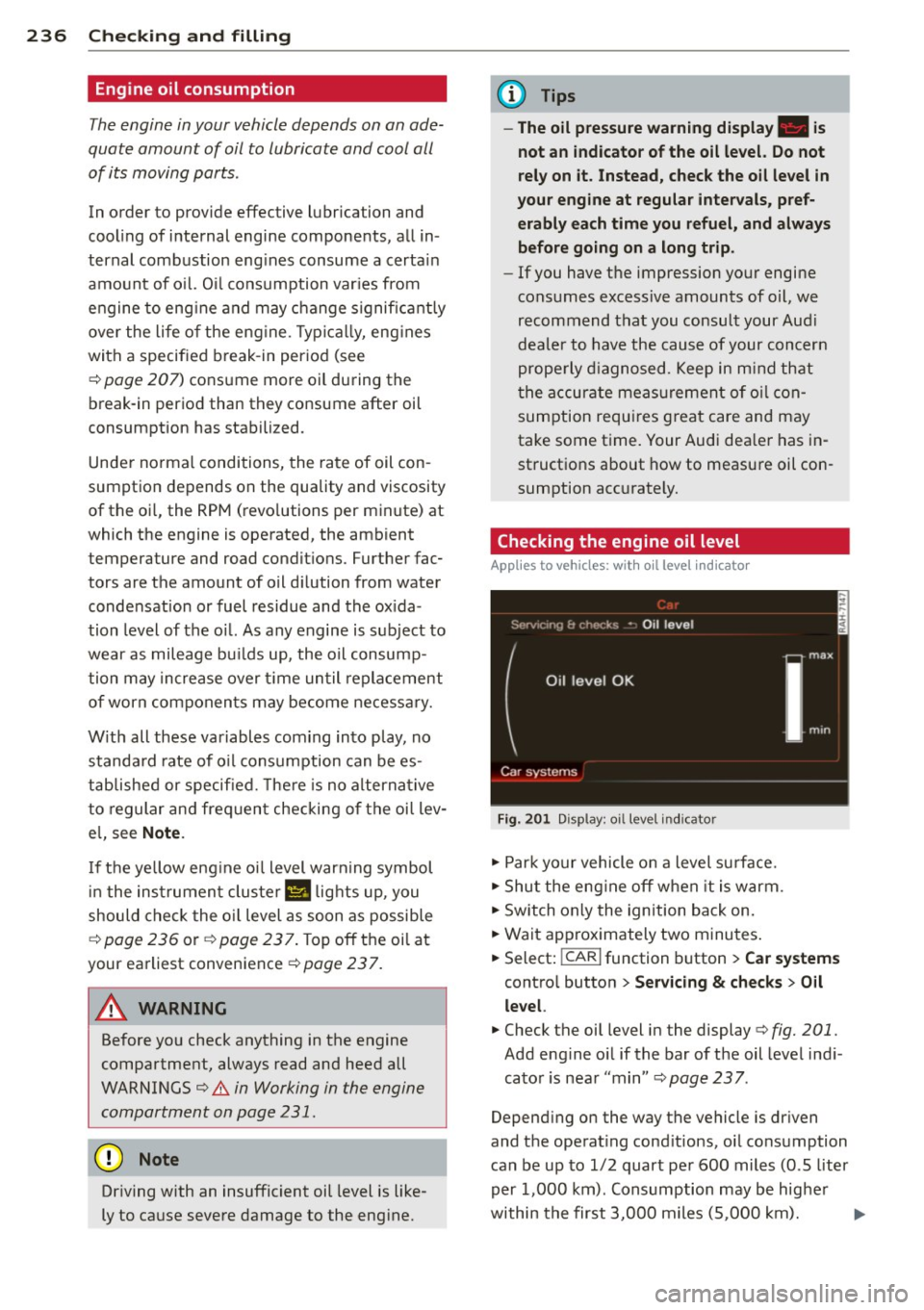
236 Check ing and filling
Engine oil consumption
Th e e ngine in your vehicle depends on an ad e
quate amount of oil to lubricate and cool all
of its moving parts.
In o rder to prov ide effec tive l ubrication and
c o oling of i nternal engi ne components, all in
t e rnal com bustion eng ines consume a certa in
a m ount of o il. O il consumption var ies from
engine to eng ine and may change significant ly
ove r the life o f the eng ine . T ypica lly, eng ines
with a specified break -in per iod (see
<=>
page 207) cons ume more oil during the
break -in period than they consume after oil
consumption has stabilized.
Under normal conditions, the rate of oil con
sumption depends on the quality and viscosity
of the oi l, the RPM (revo lutions per minute) at
which the engine is operated, the ambient
temperature and road condit ions. Further fac
tors are the amount of oil d ilution from water
condensation or fuel residue and the ox ida
tion level of the oil. As any engine is subject to
wear as mileage bu ilds up, the oil consump
tion may in crease over t ime un til replacement
of worn componen ts may become necessa ry.
W ith all these var iables coming into play, no
standa rd rate of o il consumption can be es
tablished or specified. The re is no alterna tive
to regular and frequen t checking of the oi l lev
e l, see
Note .
If the ye llow eng ine o il level warn ing symbol
in the in strumen t cluste r
II lights up, you
should c heck t he o il level as soon as possible
<=> page 236 or ¢page 237. Top off the oi l at
your ea rliest convenience <=>
page 23 7.
.&_ WARNING
Before you check anything in the engine
compartment, always read and heed all
WARNINGS
c::> ..&. in Working in the engine
compartment on page 231 .
(D Note
Driving with an insufficient oi l level is like
ly to ca use severe damage to the eng ine.
-
(D Tips
- The oil pressure warn ing display. is
not an indicator of the oil level. Do not
r ely on it. Instead, check the oil level in
your engine at regular intervals, pref
erably each time you refuel , and always
before going on a long trip .
-If you have the impression your engine
cons umes excessive amounts of oil, we
recommend that you consult your Aud i
dea ler to have the cause of your con cern
prope rly d iagnosed. Keep in m ind that
t he accurate meas urement o f oil c on
sumption requ ires great care and may
take some t ime. Your Audi dea le r has in
struct ions about how to measu re oil con
sumption acc urately.
Checking the engine oil level
Applies to vehicles : wit h oil level indicator
Fig . 201 Disp lay: o il leve l in dicator
.,. Par k your vehicle o n a level su rface.
.. Shu t the eng ine off w hen it is warm.
.. Switch only the ignition back on.
.. Wait approximately two minutes .
.. Select:
!CAR I function button > Car systems
contro l button > Servicing & checks > O il
level.
.. Check the oil level in the display c::> fig. 201.
Add engine o il if the bar of the oil level ind i
cato r is nea r "min"
c::> page 23 7.
Depend ing on the way the vehicle is dr iven
and the operat ing cond it ions, o il cons umption
can be up to 1/2 quart pe r 600 miles (0 .5 liter
per 1 ,000 km) . Consumption may be highe r
within the first 3,000 m iles (5,000 km).
1111>
Page 242 of 314
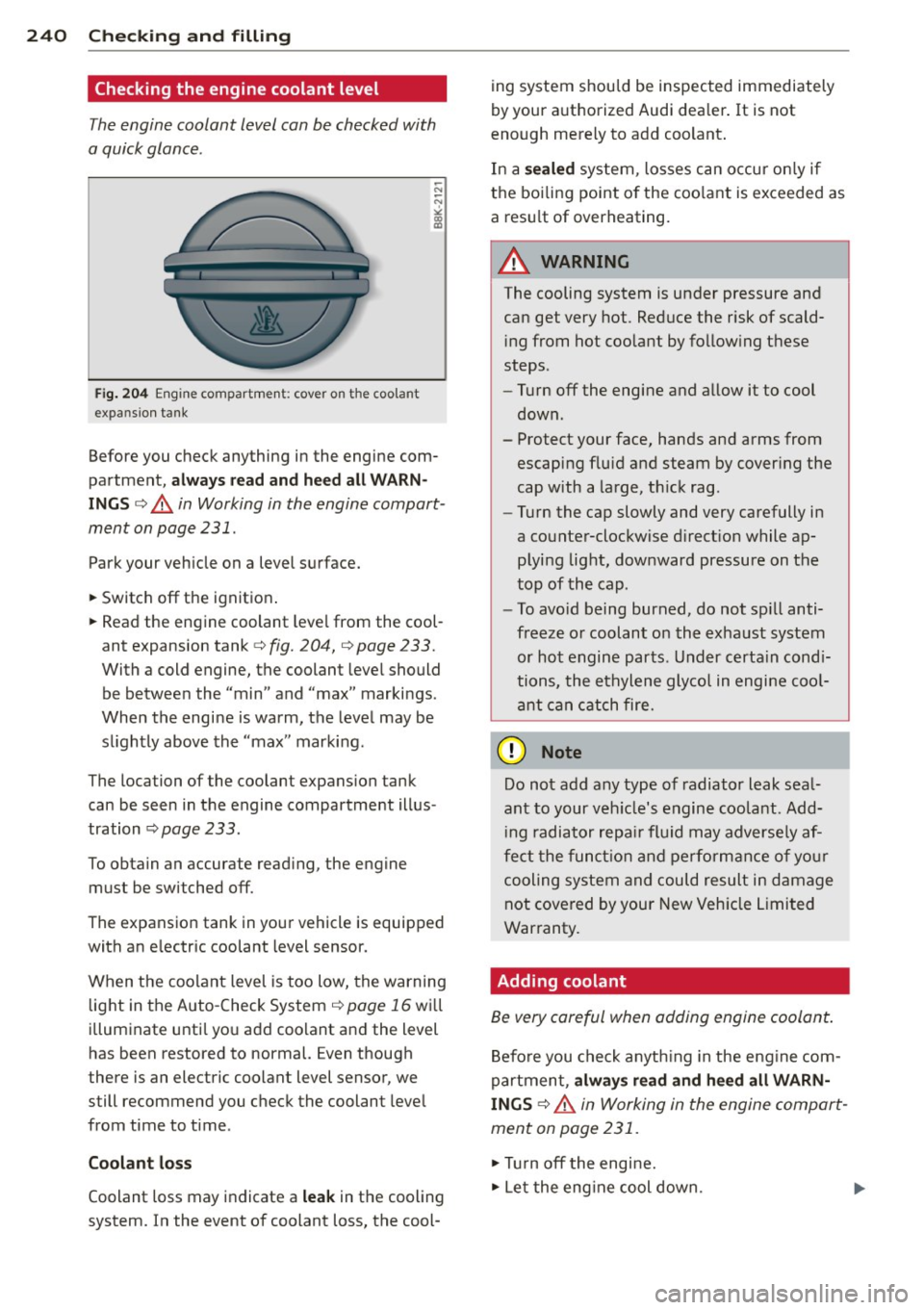
24 0 Ch eck ing and filling
Checking the engine coolant level
The engine coolant level can be checked with
a quick glance .
Fig . 204 Eng ine compartment: cover on the coolant
expa nsion tank
Before you check anything in the engine com
partment,
a lwa ys re ad and h eed a ll WA RN
INGS o .A in Working in the engine compart
ment on page 231 .
Park your vehicle on a level surface.
• Switch
off the ignition .
• Read the engine coolant leve l from the cool
ant expansion tank
o fig. 204, o page 233.
With a cold engine, the coolant level should
be betwee n the "min" and "max" markings.
When the engine is warm, the level may be slightly above the "max" marking .
The location of the coolant expans ion tank
can be seen in the engine compartment illus
tration
o page 233.
To obtain an accurate reading, the engine
must be switched
off.
The expansion tank in your vehicle is equipped
with an e lectric coolant level sensor.
When the coolant level is too low, the warning
light in the Auto-Check System
o page 16 wi ll
illuminate unti l you add coolant and the level
has been restored to normal. Even though
there is an electric coolant level sensor, we
still recommend you check the coolant level
from time to time.
Coolant l oss
Coolant loss may indicate a le ak in the cooling
system. In the event of coolant loss, the cool- ing system shou
ld be inspected immediately
by your authorized Audi dea ler . It is not
enough mere ly to add coo lant .
In a
sea le d system, losses can occur on ly if
the boiling point of the coo lant is exceeded as
a res ult of overheating.
A WARNING
-The cooling system is under pressure and
can get very hot. Red uce the risk of scald
i ng from hot coolant by fo llow ing these
steps.
- Turn
off the engine and allow it to cool
down.
- Protect your face, hands and arms from
escaping flu id and steam by covering the
cap with a large, th ick rag.
- Turn the cap slowly and very carefully in
a counter-clockwise d irect ion while ap
plying light, downward pressure on the
top of the cap.
- To avo id being burned, do not sp ill anti
freeze or coolant on the exhaust system
or hot engine parts. Under certa in cond i
tions, the ethylene glycol in engine cool
ant can catch fire.
0 Note
Do not add any type of radiator leak seal
ant to your veh icle's engine coolant . Add
i ng radiator repa ir fluid may adverse ly af
fect the funct io n and performance of your
cooling system and could result in damage not covered by your New Vehicle Limited
Warranty.
Adding coolant
Be very careful when adding engine coolant .
Before you check anyth ing in the eng ine com
partment,
alw ay s re ad and h eed all WARN
IN GS o .A in Working in the engine compart
ment on page 231.
• Tu rnoff the engi ne.
• Let the eng ine cool down.
Page 243 of 314
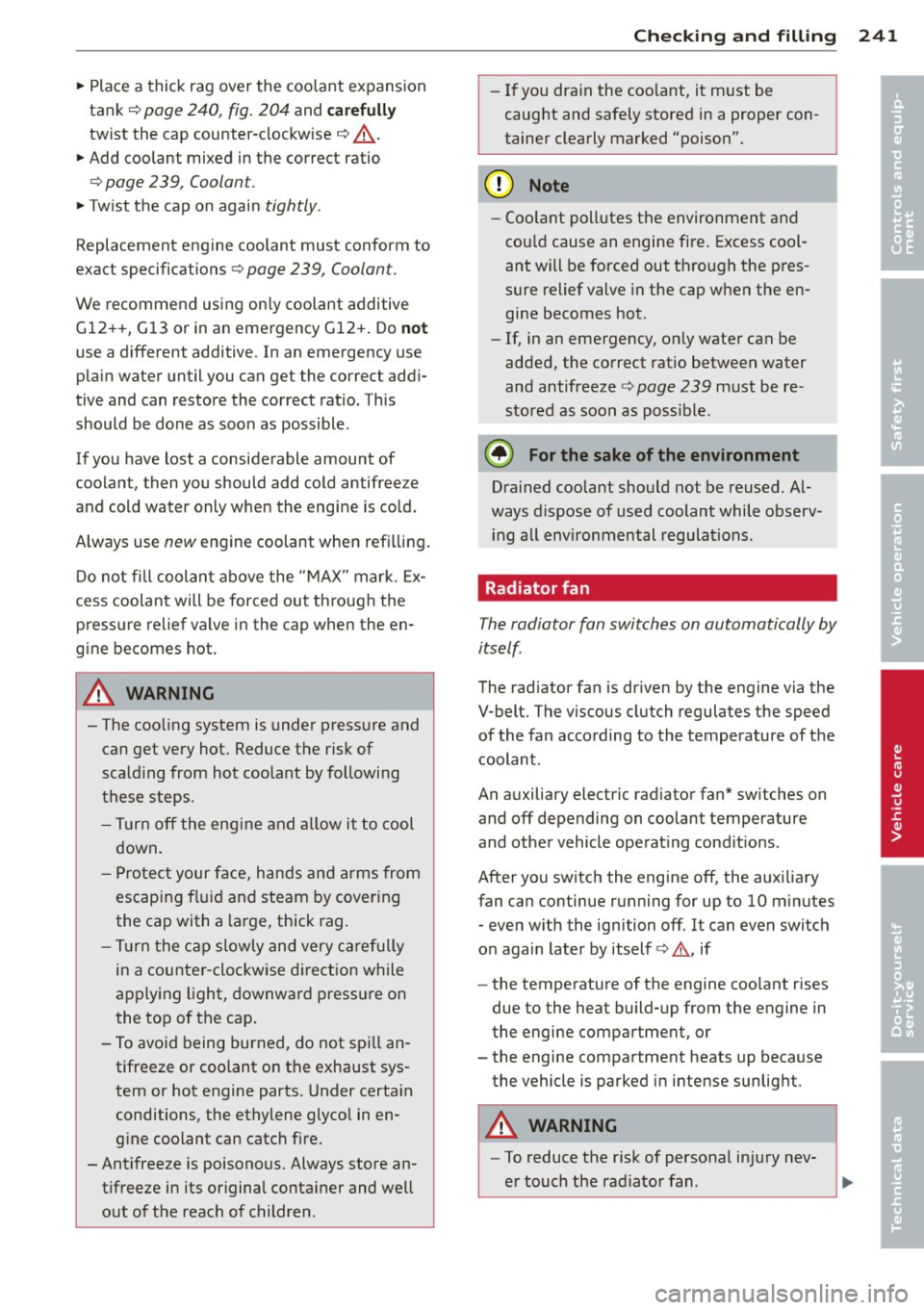
~ Place a thick rag over the coolant expansion
tank
¢ page 240, fig . 204 and car efull y
twist the cap counter-clockwise ¢ ,A.
~ Add coolant mixed in the correct ratio
¢ page 239, Coolant.
~ Tw ist the cap on again tightly .
Replacement engine coolant must conform to
exact specifications ¢
page 239, Coolant .
We recommend using on ly coolant additive
G12 ++, G 13 or in an emergency G12 +. Do
not
use a different additive. In an emergency use
pla in water until you can get the correct addi
tive and can restore the correct ratio. This
should be done as soon as possible .
If you have lost a considerable amount of
coolant, then you should add co ld antifree ze
and cold water only when the eng ine is co ld.
A lways use
new engine coolant when ref illing.
D o not fill coolan t above the "M AX " mar k. Ex
cess coolan t will be forced ou t th rough the
p ress ure re li ef va lve in the cap when the en
gine becomes hot .
&_ WARNING
- The coo ling system is under press ure and
can get very hot. Reduce the risk of
sca ld ing from hot coolant by f ollowing
these steps .
-Tu rn off the engine and a llow i tto cool
down.
- P rotec t your f ace, hands an d ar ms from
escaping f lu id and ste am by cover ing
the cap with a large, thick rag.
- Tu rn the ca p slowly and very ca re fully
in a counte r-clockwise d irect ion while
app ly ing light, downwa rd p ress ure on
the top of the cap.
- To avo id being burned, do not sp ill an
tifreeze or coolant on the exhaust sys
tem or hot engine parts . Under certa in
conditions, the ethylene glyco l in en
g ine coolant can catc h fire.
- Antifreeze is poisonous. Always store an
t ifreeze in its or iginal container and well
o ut of the reac h of children .
Checkin g and fillin g 241
-If you dra in the coo lant, it m ust be
caught and safely stored in a pr oper con
tainer clearly marked "poison".
([) Note
-Coo lant poll utes the environment and
co uld cause an engine fi re . Excess cool
ant will be forced out th ro ugh the pres
sure relief valve in the cap when the en
gine becomes hot .
- If, in an eme rgency, only wate r can be
added, the correct ratio between water
and antifreeze ¢
page 239 must be re
stored as soon as poss ible .
@) For the sake of the environment
Drained coola nt should not be reused. A l
ways d ispose of used coolant while observ
i ng all env iro nmental regula tions .
Radiator fan
The radiator fan switches on automatically by
itself .
The rad iator fan is dr iven by the engine via the
V-belt. The viscous clutch regulates the speed
of the fan acco rding to the temperature of the
coolant .
An auxiliary electric radiator fan* sw itches on
and off depending on coolant temperature
and othe r vehicle operat ing cond it io ns.
After you switch the engine off, the aux iliary
fan can continue running for up to 10 m inutes
- even w ith the ignition off . It can even switch
o n aga in later by itself¢
A, if
- the temperature of the engine coo lant rises
due to the heat build- up from the engine in
the engi ne compa rtment, or
- the engine compa rtment heats up because
the vehicle is parked in intense sunlig ht.
&_ WARNING
- To reduce the risk of perso nal inj ury nev-
er touch the radiator fan .
II>-
•
•
Page 245 of 314
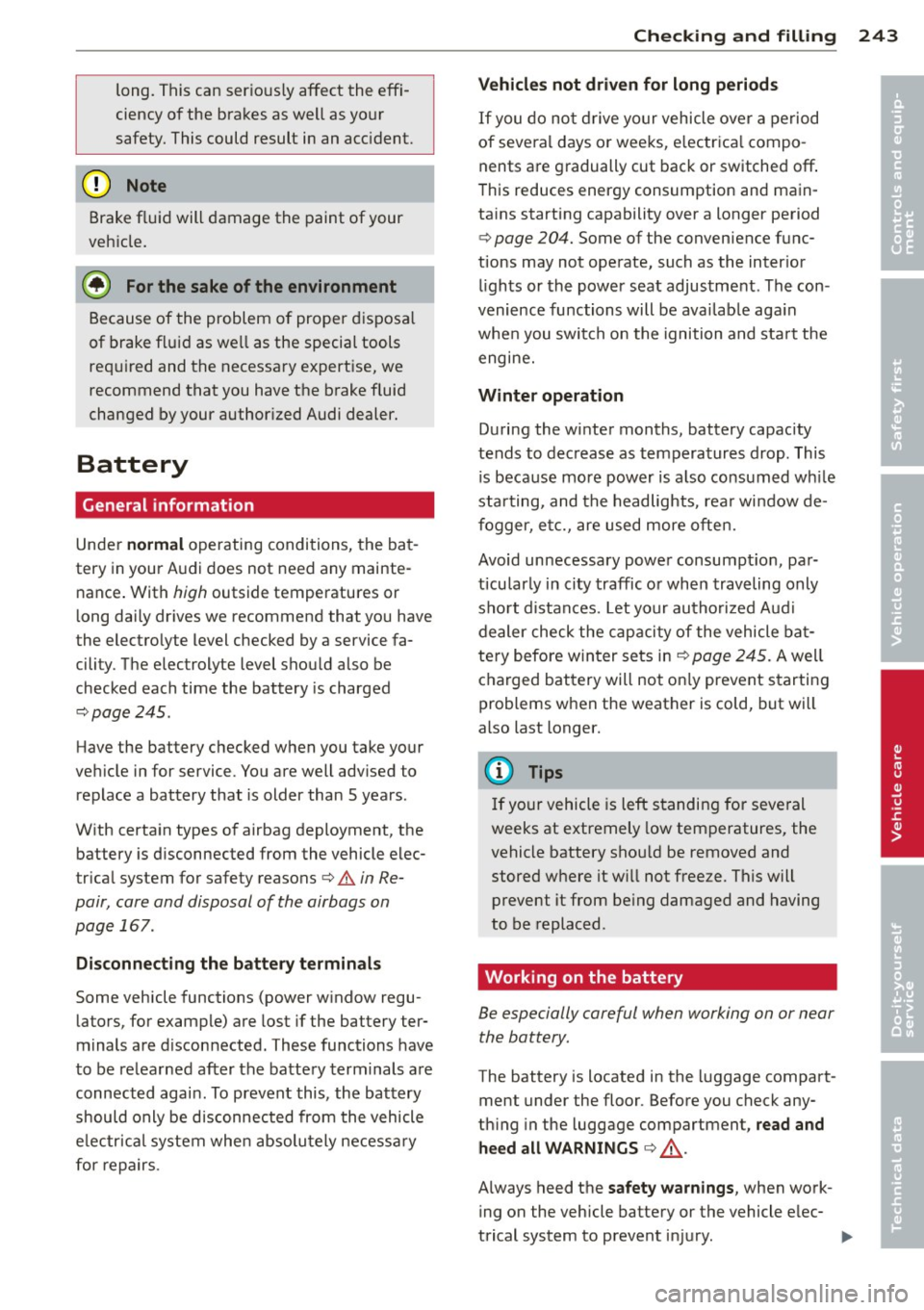
long. This can seriously affect the effi
ciency of the brakes as well as yo ur
safety. This could result in an acc ident.
0 Note
Brake f luid will damage the paint of your
vehicle.
@ For the sake of the environment
Because of the problem of proper d isposa l
of brake fl uid as we ll as the special tools
req uired and the necessa ry expert ise, we
recommend that you have the brake fluid
changed by your author ized Audi dealer.
Battery
General information
Under normal operating conditions, the bat
tery in your A udi does not need any mainte
nance . With
high outside temperatures or
long dai ly dr ives we recommend that you have
the electro lyte level checked by a service fa
cility. T he electrolyte level shou ld also be
checked each time the battery is charged
-:;, page 245.
Have the battery checked when you take your
ve hicle in for service. You are well adv ised to
replace a battery that is older than 5 years.
W ith certa in types o f airbag deployment, the
battery is d isconnected from the vehicle elec
tr ica l system for safety reasons¢
& in Re
pair, care and disposal of the airbags on
page 167.
Disconnect ing the battery terminals
Some vehicle functions (power w indow regu
lators, for example) are lost if the battery ter
minals a re d isconnected. These functions have
to be relearned after the battery terminals a re
connected again . To prevent this, the battery
should only be d isconnected from the vehicle
e lec trica l system whe n absolu tely ne cessa ry
f or repairs.
Checkin g and fillin g 243
Vehicles not driven for long periods
If you do no t drive your vehicle over a period
of seve ra l days o r weeks, e lectr ica l compo
nents are g radually cut back or switched off .
This reduces energy consumption and main
ta ins starting capability over a longer period
¢
page 204. Some of the convenience func
tions may not operate, such as the inter ior
l igh ts or the power seat adjus tment. The con
venience functions will be ava ilab le aga in
whe n you swi tch on the ignition and sta rt the
engine.
Winter operation
During the winte r months, battery capacity
tends to dec rease as temperatures drop. This
i s because more power is a lso consumed wh ile
s ta rt ing, and the headlight s, rea r window de
fogger, e tc., are used more ofte n.
Avoid unnecessary powe r consumpt ion, par
ticu larly in city traffic o r when traveling only
sho rt distances. Let yo ur au thoriz ed Aud i
de aler check the cap acity of the vehicle b at
tery before winter sets in~ page 245. A well
charged bat tery will not on ly prevent starting
problems w hen the weather is cold, but w ill
a lso last longer.
{!) Tips
If yo ur vehicle is left s tandin g for seve ral
weeks at extreme ly low tem peratures, the
vehicle battery sho uld be removed and
stored w here it w ill not freeze . T his will
prevent it from be ing damaged and having
to be replaced.
Working on the battery
Be especially careful when working on or near
the battery.
The battery is located in the luggage compart
ment under the floor. Before you check any
th ing in the luggage compartment,
read and
heed all WARNINGS
¢ .&_ .
Always heed the safety warnings , when work
ing on the vehicle battery or the vehicle e lec
trical system to prevent injury. •
•